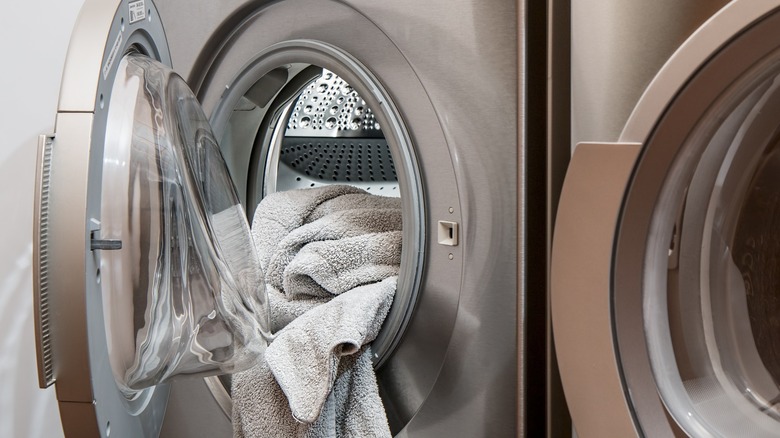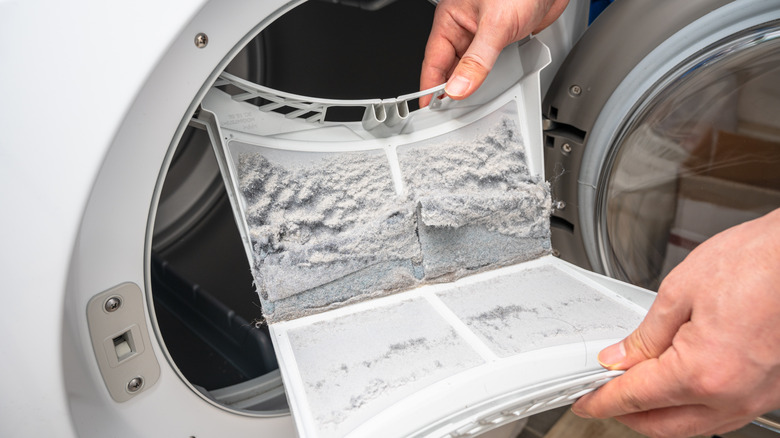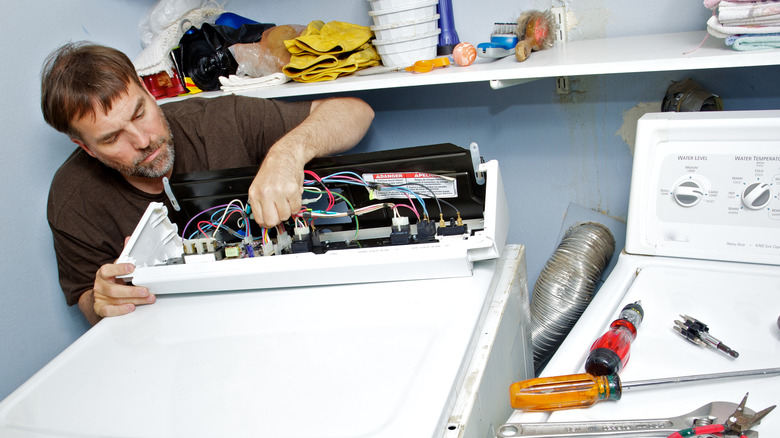Here's Why Your Dryer's Timer Estimate Doesn't Tell The Truth
You need to get something washed and dried in time to start your day. As you pop your item into the dryer, you count on it being ready to go when you are — but then there's a delay.
It's not uncommon for the dryer's timer estimate to be inaccurate. The most common reason it does this is the sensor dry feature, a small sensor that helps to determine how much moisture is still left in the materials, and a common laundry machine setting. If it detects a higher level of moisture, it adds more time to the drying cycle, with the goal of reaching a true "dry" level.
That's the most common reason time is added, but the more important element for this is the "why" behind it. Understanding why your clothes aren't drying fast enough could give you some insight into a few upgrades and maintenance tasks that could help to speed up the drying time on most of your clothing. Always start with taking a quick look at the dryer's owner's manual to make sure you know you're using these features properly. Then, consider a few simple changes that can help you avoid having to wait around for clothes to dry.
It could be operator error
Sometimes the dryer's timer just keeps going because of what it's trying to do. If you overload the dryer with too many pieces of clothing, that's going to make it take much longer to dry. In addition, it cannot get a good sense of the moisture level in the space thanks to the compact mass of clothing since the clothing cannot move around as easily as it should. It's also a good idea to spread out the clothes, ensuring they are not all wrapped up in a tight ball.
The same type of problem can occur when the dryer needs maintenance. Have you cleaned out the lint trap? Many dryers recommend doing this with every load, but your owner's manual can offer more insight into this.
Second, consider the dryer vent. It typically becomes blocked with dust and debris and must be cleaned routinely to ensure air can move freely through it. If either of these areas is blocked up and air circulation is poor, the moisture sensor may simply not work as well as it should. You can hire a professional to remove and clean the dryer vent or learn how to clean it yourself. Doing so is also a safety precaution. This, too, will help improve the length of the dryer cycles.
Common dryer mechanical problems
Sometimes, the clothing is dry, and the timer is still running. That's even more frustrating when you're in a rush. It could be the result of a broken dryer timer or cycling thermostat. The timer motor may become stuck, seemingly refusing to move through the dryer cycle, often causing the dryer to continue to run until someone notices. To find out if this is the problem, test it using a multimeter tool which will measure the voltage moving through the system. Unplug the dryer and then touch the multimeter probe to the terminals located on the timer motor. To find the timer motor, you'll need to use the owner's manual. If it's not getting 2,000 to 3,000 ohms, it's time for a repair.
A secondary concern is with the cycling thermostat, which helps to control the temperature within the dryer's drum, or the place where you put wet clothing. When it's not working properly, the dryer has no ability to control the temperature within the drum, which can mean it is operating at the wrong temperature, therefore not drying the clothing properly. You can also test this component with the multimeter tool by checking its resistance. A reading of zero is ideal. Anything else may require repairs and replacement.
In these situations, it's often easiest to turn to an appliance repair technician to ensure the specific problem receives the attention needed (especially if you don't want to buy and learn to use a multimeter tool).


